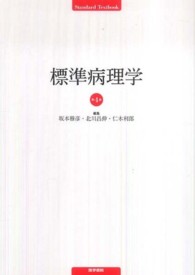Full Description
The nature of the military institution in Brazil, its relations with civilian governments up to 1964, and its use of power since the coup of that year are examined by Alfred Stepan. Throughout his study, while looking at the Brazilian experience, he tests and reformulates implicit and explicit models, propositions, and middle-range hypotheses in the literature of civil-military relations and in political development theory. Professor Stepan's analysis suggests that many of the expectations and hypotheses held by theoreticians and policymakers about the capabilities of the military in modernization need to be seriously qualified. His discussion of the socio-economic origins and career patterns of the officer corps and of the ideological changes within the Brazilian army makes extensive and systematic use of previously unexploited data: Brazilian military academy files, editorials, interviews with military and civilian leaders. Throughout, the experiences of Asian and African countries are compared to that of Brazil, thus providing a wide comparative framework. Contents: PART I: The Military in Politics: The Institutional Background. 1.
Military Organizational Unity and National Orientation: Hypotheses and Qualifications. 2. The Size of the Military: Its Relevance for Political Behavior. 3. Social Origins and Internal Organization of the Officer Corps: Their Political Significance. PART II: The "Moderating Pattern" of Civil-Military Relations: Brazil, 1945-1964. 4. Civilian Aspects of the "Moderating Pattern." 5. The Functioning of the "Moderating Pattern"--A Comparative Analysis of Five Coups, 1945-1964. PART III: The Breakdown of the "Moderating Pattern" of Civil-Military Relations and the Emergence of Military Rule. 6. The Growing Sense of Crisis in the Regime, 1961-1964: Its Impact on the "Moderating Pattern." 7. The Impact of Political and Economic Crises on the Military: Growth of Institutional Fears, 1961-1964. 8. The Impact of Political and Economic Crises on the Military: The Escola Superior de Guerra and the Development of a New Military Ideology. 9. The Assumption of Power--The Revolution of 1964. PART IV: The Brazilian Military in Power, 1964-1968: A Case Study of the Political Problems of Military Government. 10. The Military in Power: First Political Decisions and Problems. 11.
Military Unity and Military Succession: An Elite Analysis of the Castello Branco Government. 12. The Military as an Institution Versus the Military as Government. Index. Originally published in 1971. The Princeton Legacy Library uses the latest print-on-demand technology to again make available previously out-of-print books from the distinguished backlist of Princeton University Press. These editions preserve the original texts of these important books while presenting them in durable paperback and hardcover editions. The goal of the Princeton Legacy Library is to vastly increase access to the rich scholarly heritage found in the thousands of books published by Princeton University Press since its founding in 1905.
Contents
*Frontmatter, pg. i*Contents, pg. vii*List of Tables and Figures, pg. ix*Acknowledgments, pg. xi*Introduction, pg. 1*Chapter 1. Military Organizational Unity and National Orientation: Hypotheses and Qualifications, pg. 9*Chapter 2. The Size of the Military: Its Relevance for Political Behavior, pg. 21*Chapter 3. Social Origins and Internal Organization of the Officer Corps: Their Political Significance, pg. 30*Chapter 4. Civilian Aspects of the "Moderating Pattern", pg. 67*Chapter 5. The Functioning of the "Moderating Pattern"- A Comparative Analysis of Five Coups, 1945-1964, pg. 85*Chapter 6. The Growing Sense of Crisis in the Regime, 1961-1964: Its Impact on the "Moderating Pattern", pg. 134*Chapter 7. The Impact of Political and Economic Crises on the Military: Growth of Institutional Fears, 1961-1964, pg. 153*Chapter 8. The Impact of Political and Economic Crises on the Military: The Escola Superior de Guerra and the Development of a New Military Ideology, pg. 172*Chapter 9. The Assumption of Power- The Revolution of 1964, pg. 188*Chapter 10. The Military in Power: First Political Decisions and Problems, pg. 216*Chapter 11. Military Unity and Military Succession: An Elite Analysis of the Castello Bronco Government, pg. 229*Chapter 12. The Military as an Institution Versus the Military as Government, pg. 253*Conclusion, pg. 267*Appendix, pg. 273*Selected Bibliography, pg. 277*Index, pg. 297








